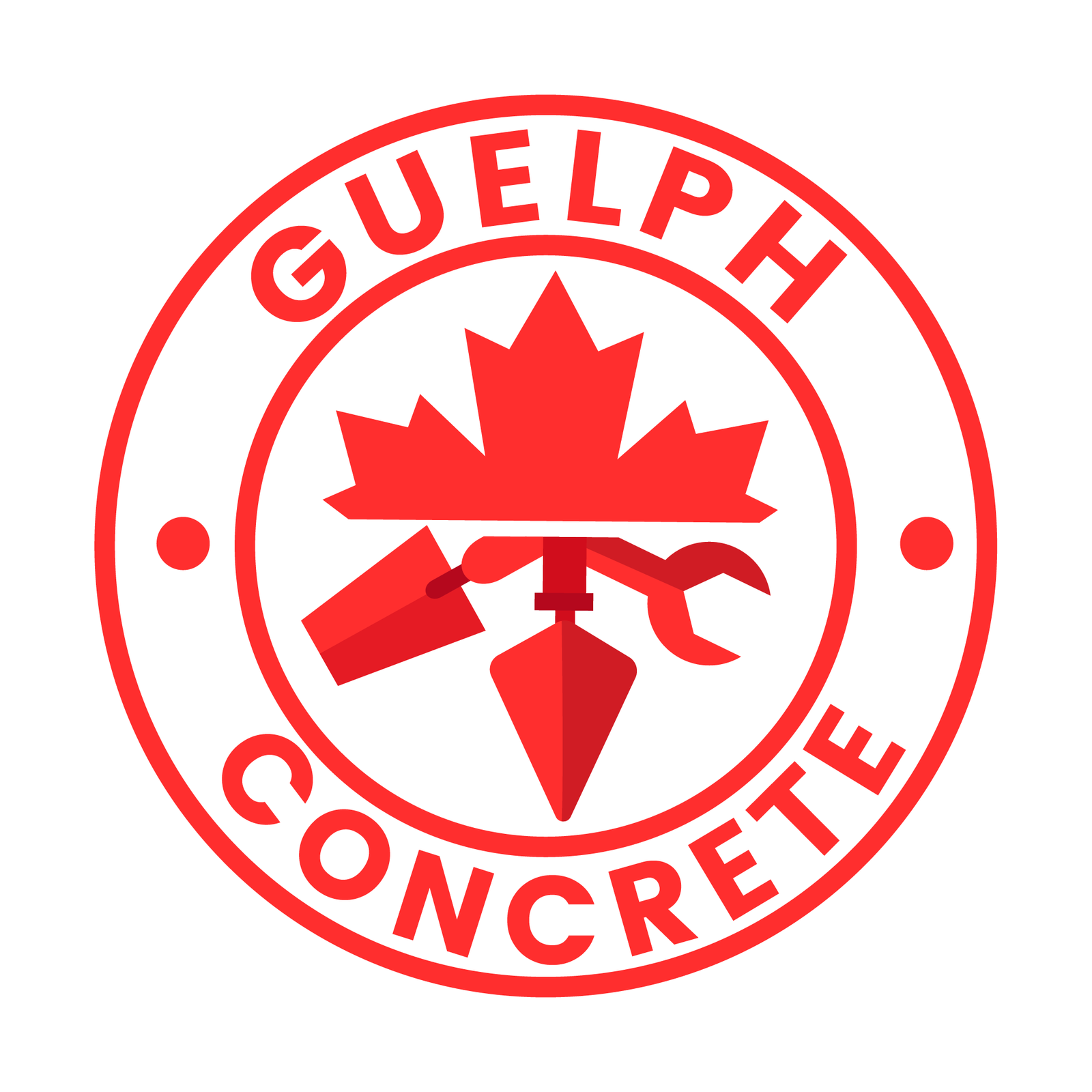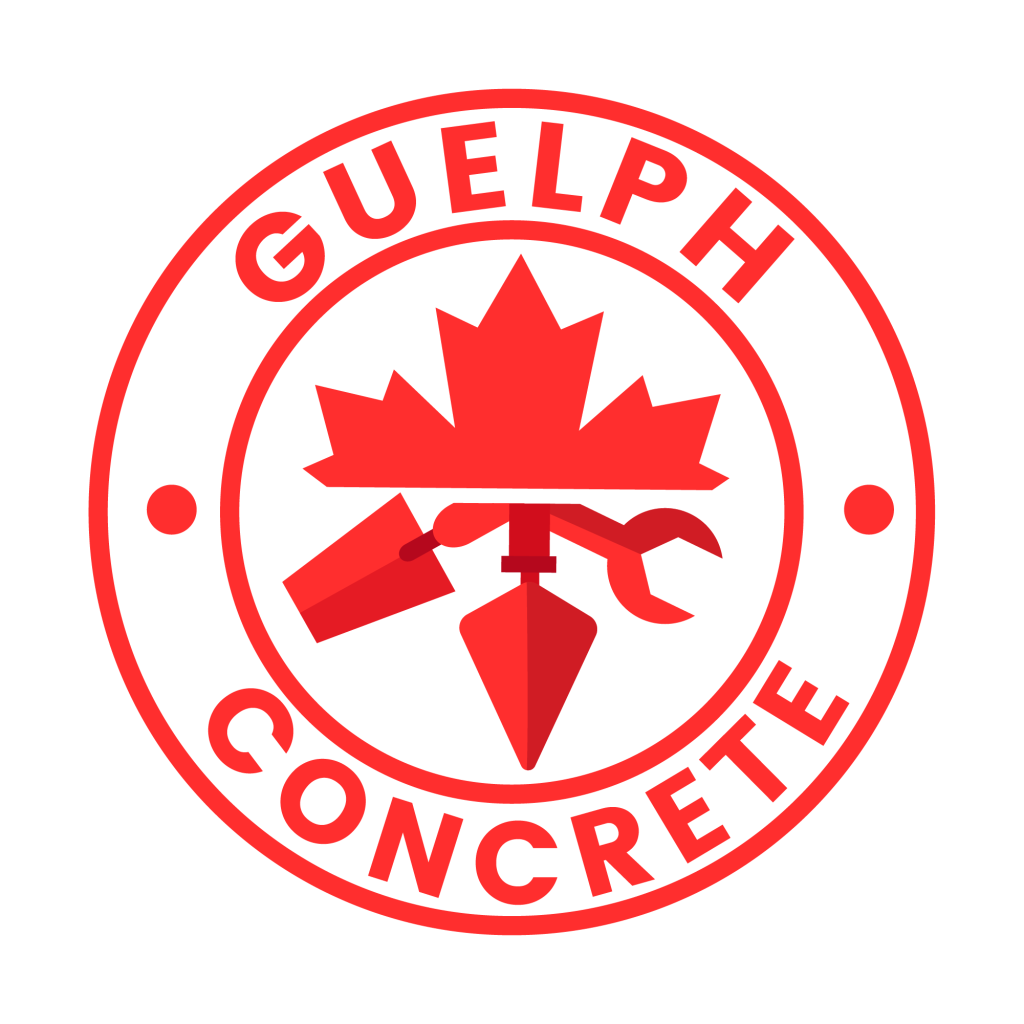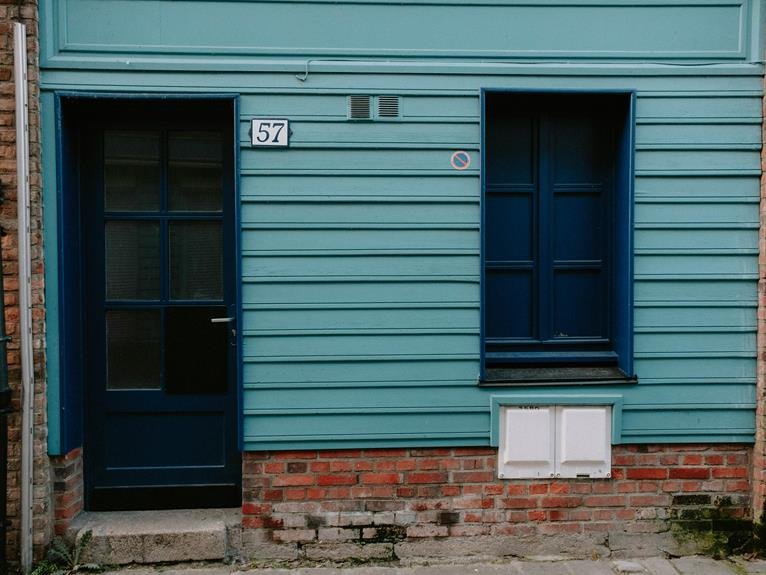At Guelph Concrete LTD, we have over 15 years of experience in waterproofing brick foundations in Guelph, Ontario. To ensure your foundation remains dry and protected, we start by thoroughly assessing it for cracks, mold, or water stains.
Next, we meticulously clean and dry the surface using a pressure washer and wire brush. We then apply an asphalt-modified polyurethane membrane evenly, ensuring comprehensive coverage over all corners and seams. To further manage water flow, we install a French drain and, if necessary, a sump pump.
Any cracks are sealed with a high-quality polyurethane sealant, and we guarantee proper grading around the foundation to direct water away from your home. Regular inspections are crucial for maintaining the effectiveness of our waterproofing solutions.
Trust Guelph Concrete LTD for a dry, protected foundation. Contact us today for a free estimate at 548-490-2074. Let our experts handle your waterproofing needs with professionalism and expertise.
Assessing the Brick Foundation
Let’s start by thoroughly inspecting the brick foundation for any cracks, deterioration, or signs of water infiltration. This step is vital because it helps us identify existing issues that need immediate attention. We’ll look for efflorescence, mold growth, or damp spots on the interior walls—these are telltale signs of water penetration.
Given the age of the brick foundation, we must be mindful of its vulnerability to damage. Older foundations often have more wear and tear, making them more prone to cracking and water infiltration.
We should also evaluate the soil conditions around the foundation. Poor soil drainage can worsen water infiltration issues, making it important to take this factor into account when planning our waterproofing strategy.
Cleaning and Preparing the Surface

Before we can apply any waterproofing materials, we need to thoroughly clean the brick foundation to make sure the surface is free of dirt, debris, and old paint. Proper surface preparation is vital for the waterproofing sealer to adhere correctly and provide long-lasting protection.
First, let’s start with pressure washing. Using the appropriate pressure washing techniques guarantees we remove all contaminants without damaging the brick. Here’s how we can do it efficiently:
- Inspect the Foundation: Look for any cracks, gaps, or damage that need repairing before we proceed.
- Pressure Washing: Set the pressure washer to a medium setting, aiming to remove dirt, debris, and old paint without chipping the brick.
- Scrub with a Wire Brush: Focus on areas with loose mortar or deteriorated spots. A thorough scrub ensures all fragile materials are eliminated.
- Let It Dry: Make sure the foundation is completely dry before moving on to the next steps.
Taking these steps in our surface preparation process creates a clean and stable base for applying the waterproofing membrane. This preparation stage may seem tedious, but it’s essential for achieving the best results and securing our foundation withstands the elements in Guelph, Ontario.
Applying Waterproofing Membrane
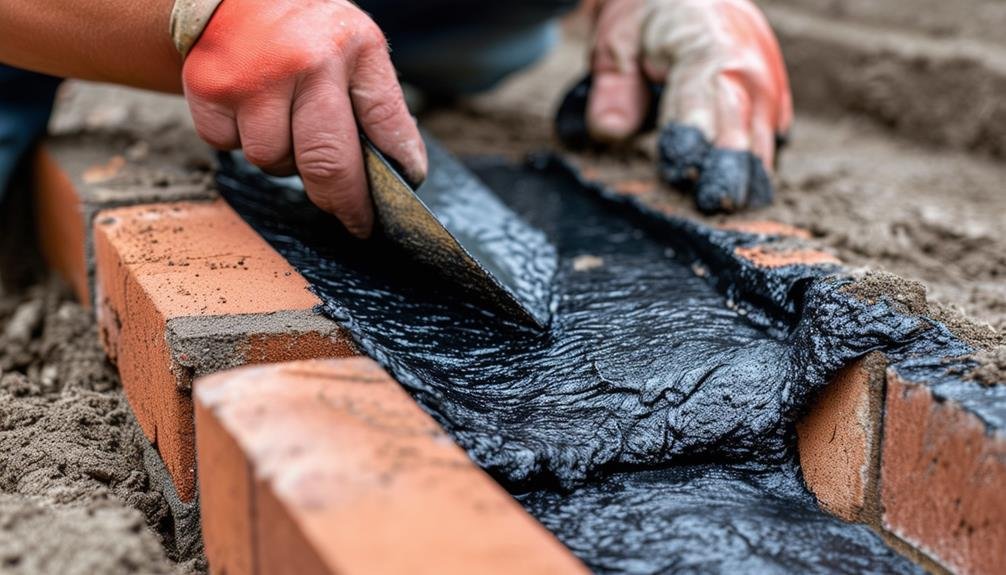
With the foundation now thoroughly cleaned and dry, it’s time to apply the waterproofing membrane to shield our brick foundation from water infiltration. Choosing the right materials is important for this step. Most commonly, waterproofing membranes are made of asphalt-modified polyurethane or rubberized asphalt, both excellent options for creating a durable barrier.
Given the climate considerations in Guelph, Ontario, we need a membrane that can withstand both harsh winters and wet seasons. Rubberized asphalt is particularly effective in colder climates as it remains flexible and adheres well to brick surfaces, even in freezing temperatures. It’s crucial to check the product specifications to make sure it’s suitable for our local conditions.
Before we start, let’s make sure our application tools and safety gear are ready. We’ll roll or brush the membrane onto the brick foundation in even layers, ensuring complete coverage. Pay special attention to corners and seams, as these areas are most vulnerable to leaks. Proper application is key; overlapping sections by a few inches will create uninterrupted protection.
Installing Drainage Systems

To effectively manage water runoff and protect our brick foundation, we need to install a comprehensive drainage system around the perimeter. This essential step guarantees that water is directed away from the foundation, minimizing the risk of seepage and structural damage.
We can start by considering a few key components:
- French Drain System: Installing a French drain around the perimeter helps channel water away from the foundation. This involves digging a trench, laying perforated pipes, and covering them with gravel.
- Sump Pump Installation: Incorporating a sump pump into our drainage system is crucial for removing excess water that accumulates. This pump ensures that water is expelled efficiently, keeping the foundation dry.
- Proper Soil Grading: Ensuring the soil around the foundation is graded correctly will direct water away from the brick walls. This simple step can notably reduce water infiltration issues.
- Drainage Maintenance: Regularly maintaining our drainage system is essential to its effectiveness. Clearing any blockages and ensuring the sump pump is functioning correctly will keep our foundation safe.
When tackling foundation waterproofing, we must decide between DIY vs professional help. While some tasks can be managed independently, consulting a waterproofing specialist in Guelph can provide customized solutions to maintain our brick foundation watertight.
Sealing Cracks and Gaps
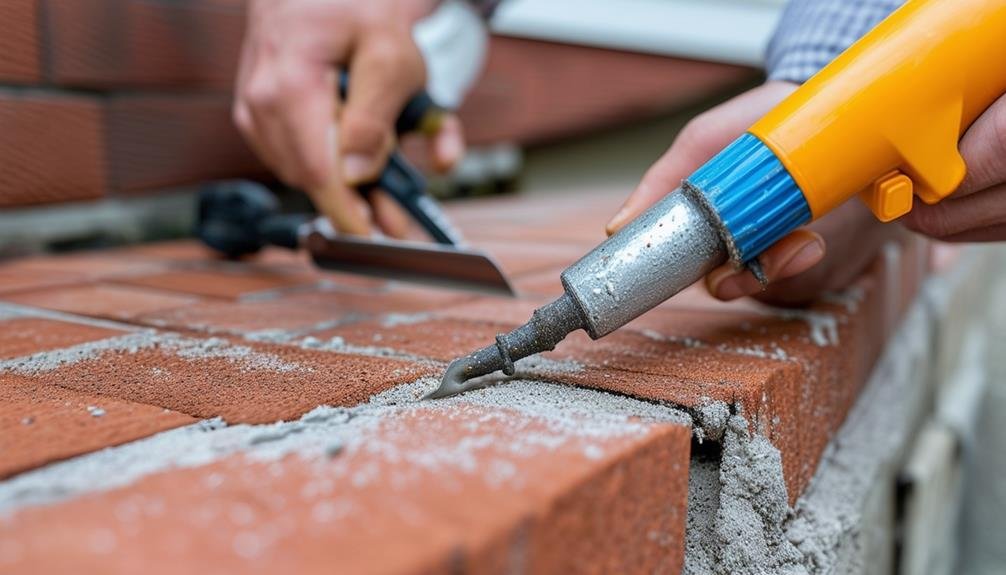
As Guelph Concrete LTD, a trusted concrete company serving Guelph, Ontario for over 15 years, we’re here to guide you through sealing cracks and gaps in your brick foundation. Our experienced team recommends starting by choosing the right sealant. For small cracks, we use high-quality polyurethane, while for larger ones, we employ hydraulic cement.
Ensuring each crack is clean and dry before application is crucial for effective sealing. To further protect your foundation, we apply a waterproofing membrane over the sealed areas and commit to regular inspections to keep water out.
If you’re dealing with cracks or gaps in your foundation, don’t hesitate to contact Guelph Concrete LTD for a free estimate. Call us today at 548-490-2074, and let our expertise work for you!
Effective Sealant Options
When it comes to sealing the cracks and gaps in a brick foundation, choosing a high-quality polyurethane sealant is fundamental for creating an effective waterproof barrier. Polyurethane sealants are known for their flexibility, durability, and resistance to water penetration, making them ideal for our needs in Guelph, Ontario.
Let’s break down why this choice matters:
- Sealant Selection: Polyurethane sealants are superior due to their elasticity and ability to expand and contract with temperature changes. This ensures the seal remains intact over time.
- Application Techniques: Proper application is essential. Ensuring a clean surface and using appropriate tools will help achieve a smooth, thorough seal.
- Long Term Effectiveness: Polyurethane’s durability means it can provide a lasting solution against water infiltration, protecting the structural integrity of our foundations.
- Reapplication Frequency: Though polyurethane sealants are long-lasting, regular inspections and maintenance are key. We should be ready to reapply as needed, typically every few years, to maintain the best waterproofing.
Preparation and Application Steps
We start by thoroughly cleaning the brick foundation to guarantee a strong bond for the sealant. Removing dirt, debris, and any loose material is important for effective waterproofing techniques. We can use a stiff brush and a hose to scrub away grime, making sure every surface is spotless.
Once the foundation is clean, we move on to sealing the cracks and gaps. Using a high-quality waterproof sealant specifically designed for brick surfaces is necessary. We apply the sealant generously, making sure it fills every crevice and covers the entire brick foundation. This step is essential for brick foundation protection, as even minor cracks can allow water to seep in, leading to significant damage over time.
After applying the sealant, we need to let it dry completely. Following the product manufacturer’s drying time recommendations is crucial to ensure the sealant sets properly. Patience here pays off, as rushing this step can compromise the waterproofing efforts.
Regular Maintenance Tips
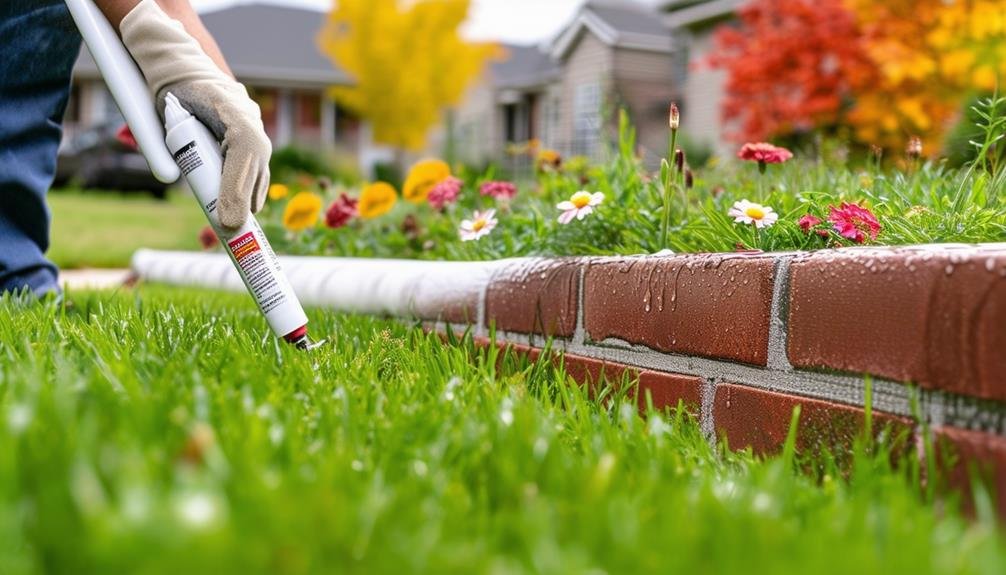
Regular maintenance of your brick foundation is essential to prevent water damage and secure the longevity of your home. By taking a proactive approach, we can avoid costly repairs and keep our homes in top shape. Here are some practical tips to guarantee our brick foundations remain strong and dry:
- Inspect Regularly: Make it a habit to inspect the brick foundation for cracks, gaps, or any signs of water penetration. Small issues can quickly escalate if left unchecked, so early detection is key.
- Seal Cracks and Gaps: Utilize DIY solutions or seek professional assistance to seal any visible cracks or gaps with appropriate waterproofing materials. This is one of the most effective preventative measures to keep water out.
- Proper Grading: Guarantee the ground around the foundation slopes away from the bricks. Proper grading prevents water from pooling around the foundation, a simple and effective reactive solution to water issues.
- Apply Waterproofing Sealant: Consider applying a waterproofing sealant specifically designed for brick surfaces. This adds an extra layer of protection and extends the life of our foundation.
Regular professional inspections and maintenance can help us address potential issues promptly. By integrating these tips into our routine, we can safeguard our homes against water damage and enjoy peace of mind.
Frequently Asked Questions
How to Waterproof a Brick Foundation?
To waterproof a brick foundation, we should inspect for damage, apply a brick sealer, and guarantee proper drainage. Adding an exterior coating and an interior sealant boosts protection. Regular maintenance keeps our foundation strong and dry.
What Is the Best Waterproofing for Exterior Foundation?
When we waterproofed our foundation, we used waterproofing membranes and coatings. Combining exterior sealants with proper drainage guaranteed long-term protection. This method’s practical, reliable, and keeps our home safe from water damage. You’ll love the peace of mind!
How Do You Waterproof a Block Foundation From the Inside?
We start by applying interior sealants and professional-grade waterproofing paint to block foundations. Next, we seal cracks with hydraulic cement and install drainage solutions like a French drain. Regular upkeep guarantees our homes stay dry and protected.
What Is the Best Method of Foundation Waterproofing?
The best method of foundation waterproofing to prevent basement leaks and a wet basement is exterior waterproofing. By applying a waterproof membrane and installing proper drainage, we can protect our foundations and secure a dry, safe home.
Conclusion
In the end, ensuring our brick foundation is waterproofed in Guelph, Ontario, is much like fortifying a castle against the elements. By evaluating, cleaning, applying membranes, installing drainage, sealing cracks, and maintaining regularly, we can protect our homes just as knights once guarded their keeps.
Let’s remember, a well-protected foundation isn’t just about today—it’s about safeguarding our future. With these steps, we’re not just homeowners; we’re stewards of our own strongholds.
